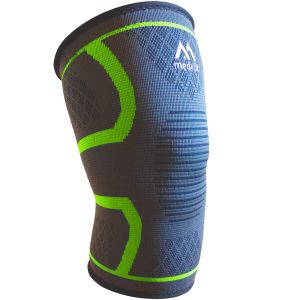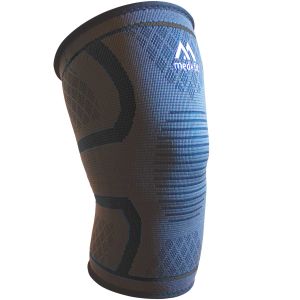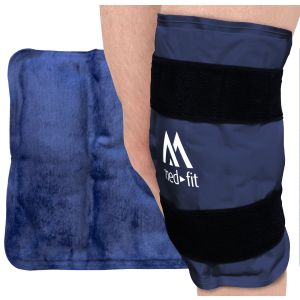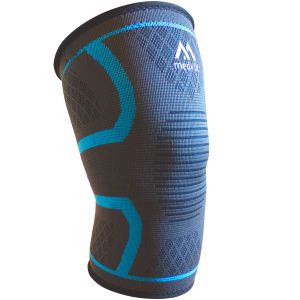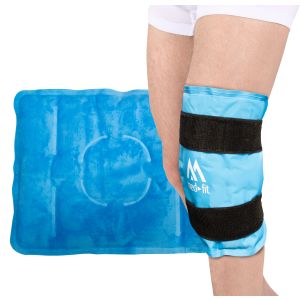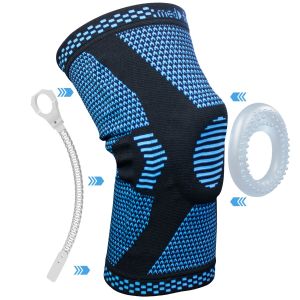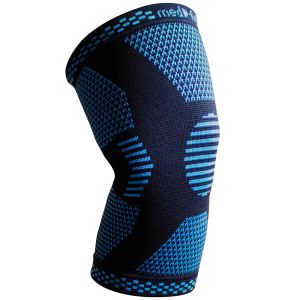Knee Support
Knee Supports & Knee Braces
Knee Supports have become a popular source of protection and stablisation for your knee, patella and muscle surrounding the knee, especially for those looking to reduce the number of knee injuries they have during exercises, activities and more.
Our Stride Flex Knee Supports come with compression, breathable and elastic fabric - the compression assists in improving blood circulation around the targeted area; reducing swelling, providing warmth and helping aid in healing and preventing injuries.
The Knee Supports come with different functions and possible uses:
1. Stride Flex Knee Supports are used for minimising swelling, accelerating healing from injuries and come with targeted compression. They are mostly used for those looking to recover from injuries, used to help prevent injuries as they come with compression which can help with stablisation, but as an added benefit, the support is created from medical grade material.
They come in:
2. Patella Tendon Knee Support - this type of knee brace is what it says on the tin, the knee support provides pressure to assist in the aid of recovery for those with injuries, such as: ACL, PCL, LCL and MCL strains.
This type of knee brace is commonly used by those with the injuries above, but also with a number of conditions such as: meniscus tears, MCL related pains, sports injury recovery and joint pain relief. This type of support comes in 5 sizes.
3. Sports Knee Brace - This specific type of knee support or brace is designed for more swift pain relief, offering professional grade compression that allows you to prevent injuries whilst undergoing various activities, sports and more. This type of support comes in 5 sizes.
Are Knee Supports good for Arthritis?
Knee Supports and Knee Braces have become a popular method of care amongst those with arthritis - The warmth they provide isn't just comforting; it's therapeutic, easing discomfort effectively. The level of support you need depends on the severity of your condition and your activity level.
For mild arthritis, our 360 compression sleeves Stride Flex Knee Supports offer targeted pain relief, even for those dealing with moderate to severe arthritis, the compression and support they provide can help assist you. It doesn't really stop there, the knee supports we have available aren't just compression, patella supports or those used for supports, but we also have those with cold therapy - our cold packs have become incredibly popular for those struggling with knee injuries, arthritis, post surgery and more.
Some users opt for knee supports with patella support openings for optimal support and protection. Whether you're recovering from an injury, dealing with ligament sprains or tears, or managing arthritis during sports or daily activities, these supports ensure proper patella alignment and efficient air ventilation.
Do Knee Supports actually work?
Knee Supports serve various purposes, including everyday support, sports and fitness, and injury rehabilitation.
- For Everyday Support: Individuals experiencing instability due to conditions like arthritis or aging find comfort and stability in wearing knee supports during their daily activities.
- Injury Rehabilitation: Healthcare and medical professionals often recommend knee braces for individuals undergoing knee surgery or recovering from knee injuries, as they aid in the rehabilitation process.
- Sports and Fitness: Knee braces and supports have gained popularity among fitness enthusiasts and athletes seeking injury prevention and performance enhancement. They provide stabilisation and support, contributing to improved performance during physical activities.
Knee supports and braces, particularly those offering 360-degree compression, have become widely favored for their reliability and durable materials.
How does Knee Support with Compression work?
Various types of knee braces are tailored to different needs and functionalities. They provide vital support by alleviating strain on knee ligaments and muscles during weight-bearing activities, particularly beneficial for individuals with knee injuries, see above the types we have available.
Knee supports act as a middle ground, offering mobility without compromising joint stability. By redistributing weight away from the knee, they mitigate strain and facilitate movement, preventing recurrent injuries.
During weight-bearing tasks, knee braces absorb pressure exerted on the knee, limiting its motion and reducing strain on the joint. This mechanism helps prevent further injuries by providing essential structural support.
Additionally, knee supports and sleeves serve a dual purpose by retaining heat around the knee area. Heat retention improves circulation and speeds up healing, particularly advantageous in colder climates where injuries heal more slowly. Furthermore, it enhances comfort by keeping the knee warm, promoting quicker recovery.
Some compression knee braces feature mechanical compression pads that help maintain the position of the kneecap, enhancing joint stability during activities. By compressing the joint, these braces restrict blood flow and swelling, facilitating greater mobility.
Typically, compression braces are worn temporarily post-surgery to support healing ligaments or during physical activity to maintain joint alignment. They also help minimise swelling and promote circulation to surrounding muscles, optimising overall knee health.
What conditions are knee supports good for?
Healthcare professionals usually recommend knee braces to address a wide array of common knee injuries and musculoskeletal conditions.
These encompass:
- Knee Sprains: Resulting from the stretching or tearing of knee ligaments due to sudden twisting or impact.
- Knee Ligament Injuries: Involving damage to crucial ligaments like the ACL, PCL, MCL, or LCL, often caused by sports-related incidents or trauma.
- Patellofemoral Pain Syndrome (PFPS): Known as runner’s knee, PFPS manifests as pain around the patella due to overuse, muscle imbalances, or misalignment.
- Patellar Instability: Characterised by recurrent dislocations or subluxations of the kneecap, leading to instability and discomfort.
- Patellar Tendinitis and Tendon Issues: Inflammation or damage to the patellar tendon due to repetitive strain or overuse.
- Patellar Dislocations: Occurring when the kneecap shifts out of its normal position, causing pain, swelling, and instability.
Beyond injury-specific treatments, knee braces & knee supports are instrumental in managing various muscle and joint-related health conditions, including:
- Peripheral Neuropathy: Affecting peripheral nerves and resulting in weakness, numbness, and knee/leg discomfort.
- Knee Arthritis: Marked by knee joint inflammation and cartilage degeneration, leading to pain, stiffness, and reduced mobility.
- Joint Hypermobility Syndrome and Ehlers-Danlos Syndrome: Conditions characterised by joint laxity and instability, heightening the risk of injuries and discomfort.
How tight should a knee support be?
The type of knee brace chosen plays a significant role in determining comfort levels during sleep. Lightweight and low-profile braces (similar to the ones above) tend to be more conducive to sleeping compared to bulkier or rigid alternatives. Some knee braces are specifically designed for overnight wear, incorporating breathable materials and ergonomic designs aimed at maximising comfort.
For some individuals, wearing a knee brace to bed can be relatively comfortable, particularly if the brace fits well and offers adequate cushioning. Nevertheless, adjusting to sleeping with a brace may take time, and initially, you may find it challenging to achieve restful sleep.
So, the short answer is yes, it’s more of a personal preference, you can sleep with your knee support still on, but it’s really up to. There are some people that find it tough or a bit difficult having a decent sleep with a knee support on, as it can limit your movement - however others sleep without any problems.

